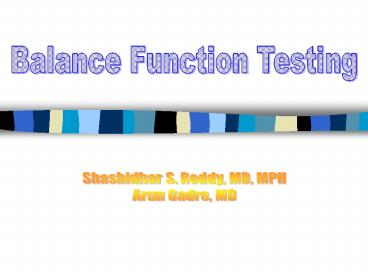Balance Function Testing - PowerPoint PPT Presentation
1 / 34
Title:
Balance Function Testing
Description:
Visual: Orientation and balance are maintained via several visual properties: Saccades ... Visual cortex centers specially designed to respond to vertical and ... – PowerPoint PPT presentation
Number of Views:268
Avg rating:3.0/5.0
Title: Balance Function Testing
1
- Balance Function Testing
- Shashidhar S. Reddy, MD, MPH
- Arun Gadre, MD
2
Physiology of Balance
- Humans use three systems
- Visual
- Proprioceptive
- Vestibular
3
Visual
- Orientation and balance are maintained via
several visual properties - Saccades
- Smooth pursuit
- Optokinetic reflex
- The optokinetic response can also impart a sense
of acceleration in an individual - Depth perception
- Visual cortex centers specially designed to
respond to vertical and horizontal stimuli
4
Proprioceptive
- Proprioception contributes to balance in the
following ways - Myototic reflex (deep tendon reflex)
- Functional stretch response
- Cervical proprioception
- Includes a cervical-ocular reflex arc that can
lead to physiologic or pathologic nystagmus
5
Vestibular
6
Semicircular Canals
- Respond to angular acceleration in the plane of
the canal. - Are functionally paired
7
Otolith organs
- Contain calcium carbonate crystals of higher
density than endolymph - This allows response to gravity (head tilt)
- Respond to linear acceleration
8
Vestibular Reflexes
- Vestibulospinal
- Helps maintain center of gravity
9
Vestibular Reflexes
- Vestibulo-ocular
- Helps maintain stability of visual field
- Leads to physiologic nystagmus
10
Vestibular Reflexes
- Vestibulo-cervical
- Helps to maintain stability of the head during
movement of the torso.
11
Balance Function Testing
- History is the most important tool in evaluation
- Must obtain a concrete description of symptoms
- Define vertigo for the patient
- Ask about onset, duration of symptoms,
aggravators, associated symptoms (hearing loss),
tinnitus, affect on daily life.
12
Bedside Evaluation
- General physical examination
- Vascular exam for possible posterior circulation
problem - Cranial nerve exam
- Cerebellar function (disdiadokinesis)
13
Bedside Evaluation
- Proprioceptive / Vestibulospinal
- Romberg
- Past-pointing
- Fukuda
- Deep tendon reflexes
- Proprioception
14
Bedside Evaluation
- Vision
- Visual acuity
- Saccades
- Smooth pursuit
- Optokinetic reflex
15
Bedside Evaluation
- Static Vestibular Balance Nystagmus
- Check direction
- Check for torsional component
- Check for gaze suppression
16
Bedside Evaluation
- Dynamic Vestibular Function Testing
- Head turn
- Tests the gain of the vestibulo-ocular reflex
- Head shaking
- Utilizes a central pathway that remembers
angular velocity
17
Bedside Evaluation
- Provocative Measures
- Hyperventilation
- Dix-Hallpike
- Valsalva
- Calorics
18
Electronystagmogram
- Utilizes charge difference between retina and
cornea to detect eye movement
19
Infrared Camera Systems
- Infrared camera directly measures eye movement
20
Electronystagmography
- Saccades
21
Electronystagmography
- Gaze
22
Electronystagmogram
- Optokinetic Nystagmus
- Positional Nystagmus
- Paroxysmal Positional Testing
- Tympanogram
- Tulio Phenomenon
23
Electronystagmogram
- Caloric Testing
24
Electronystagmogram
- Caloric Testing
25
Electronystagmogram
- Caloric Testing
26
Electronystagmogram
- Rotatory Chair
27
Dynamic Posturography
28
Dynamic Posturography
- Conditions Tested
29
Case Study
- 26 y/o woman presents to the emergency room
several hours after the sudden onset of severe
dizziness with nausea and vomiting. - You call her up to your clinic.
30
Case Study
- History reveals no associated symptoms.
- No report of hearing loss
31
Case Study
- Physical Exam
32
Case Study
- ENG
33
Case Study
- ENG
34
Case Study
- ENG































